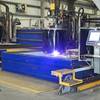Spain Introduces New Military Shipbuilder
Mr. Solbes’ referred in his speech to the creation of this new company as the start of a new future for Spanish shipyards, seeing it as an expression of the framework agreement hammered out in December last year by SEPI, Izar and shipbuilding trade unions that satisfactorily meets the aims the Government had set out to resolve the problems facing state-owned shipyards. The way ahead is paved with permanent dialogue between all parties as it is with rigorous and realistic analysis and proposals aimed at finding a solution. Mr. Martínez Robles firmly underlined the support of SEPI, the company’s sole shareholder, for Navantia’s industrial plan, insisting that it is a continuation of centuries of experience in absolutely everything relating to the Spanish Navy’s ships. Juan Pedro Gómez Jaén, Navantia’s CEO and Chairman, provided a detailed presentation of the new company and of its activities, facilities, technological and productive capabilities and of its presence in national and international markets. The new company’s corporate identity was also presented. This will be progressively introduced in all of the company’s graphic supports and will be spread into markets where its activities are currently underway. The new name aims to reflect the spirit that is born with this company:
Navantia represents advancement, naval activity and modernity. It is also a step forward. Navantia’s activities include naval construction, propulsion and energy, ship repairs, military and civil platform control systems as well as weapons. It is expected that up to 20% of the company’s entire activity will be devoted to civil applications. The new company directly inherits more than 250 years’ experience in the construction, maintenance and conversion of the Spanish Navy’s ships. Over the last three decades this has meant very close collaboration in the progressive and tough processes involved in strengthening the Spanish fleet.
The new company is therefore born as one of the international market’s leading naval military systems companies, able to undertake new buildings and carry out life-cycle maintenance and total ship conversion.
It is one of very few companies that has a complete capacity in the fields of design, development, production, integration and integrated logistic platform support, propulsion and naval combat systems as well as the ability to deliver fully operational vessels. Navantia also has an enviable product list in military and coastguard vessels and an enormous capacity for undertaking new projects.
In the year 2004 Navantia’s integrated production centres enjoyed a turnover of approximately 1.1 billion euros. These production facilities are staffed by a workforce of approximately 5,562 based on the Ferrol Estuary (Ferrol and Fene), the Bay of Cadiz (Cadiz, Puerto Real and San Fernando) and Cartagena, with the headquarters being situated in Madrid.
Navantia has formed an Innovation Department that concentrates significant effort on RDTI, something that is seen as the key to competitiveness and product differentiation. The company is also a pioneer and leader in the use of integrated modular construction of military ships. This shipbuilding system is used on all products, including submarines.
The company’s technological and productive capacities have enabled Navantia’s production centers to develop the most complex naval systems over the last few years. Outstanding in the eighties were the Príncipe de Asturias aircraft-carrier and the FFG Frigates (F-81 to 84). In the nineties, the F-85/86 frigates, the amphibious LPD vessels, combat support ships and minehunters. All of these efforts clearly show advanced platform design and on-board system development capabilities. This new century’s Strategic Deployment Ship and the S-80 submarines, among other projects, are clear illustrations of innovative technology and productive capabilities. Navantia is therefore fully equipped to respond to all of the Spanish Navy’s requirements and to be one of Spain’s main defence exporters. Products such as the aircraft carrier built for Thailand, the first new building of its kind ever sold for export, Europe’s most modern frigate built for Norway and conventional submarines being built for Chile and Malaysia. This means that the new company is now taking part in existing military programmes for Chile, Norway and Malaysia, in addition to those of Spain.
Navantia is also developing a policy of collaboration with other domestic and foreign companies through strategic product alliances for the design and sale of projects and is actively participating in innovation using internationally recognised technologies. The company currently forms part of the Afcon Consortium alongside US companies such as Bath Irons, the US Navy’s main shipbuilder, and Lockheed Martin, world leader in the design and development of combat systems. A consortium has also been formed with the French company DCN to develop the Scorpene submarines. Navantia has a complete range of products that includes aircraft carriers and amphibious vessels and this is what has enabled the company to develop the Strategic Deployment Ship, one of the most competitive ships of its kind found anywhere in the world. One of its star products is the F-100 frigate for the Spanish Navy. This ship has the world’s best cost-performance-range ratios and has given rise to Spain’s biggest ever naval innovation programme. It has also led to highly significant international industrial cooperation programmes and to an entire family of leading-edge technology ships for the export market. This has also enabled the company to become consolidated as a designer and integrator of conventional submarines.
Historical Background
On 30 July 2004 the Spanish Cabinet authorised Izar to constitute this new company in order to respond to the crisis facing these shipyard – basically due to the grave situation facing Izar and also because of the obligation to return subsidies that had been deemed incompatible with European Union norms – the framework of European law awarding independent treatment to the activity of military naval construction because of its special characteristics. The agreement signed with the trade unions on 16 December 2004 opened the way to find a solution and a future for Izar’s shipyards, including both the civil yards –through the inclusion of private venture capital- and the military ones that make up Navantia.
Once a plan of action in line with EU norms was agreed, the new company was initially constituted and was provisionally named New Izar. The aim was to integrate its military activity and enable it to carry out complementary activities in the civil field. On 17 December 2004, following the signing of the agreement, the Board of Directors of SEPI authorised Izar to transfer all the assets used for these military shipbuilding activities to New Izar and also the subsequent purchase by the State holding company of 100% of its shares.
In January this year SEPI acquired all of the shares in New Izar, now called Navantia. This was recorded in the Company Register with the increase in company capital and the share ownership that had already been executed.










